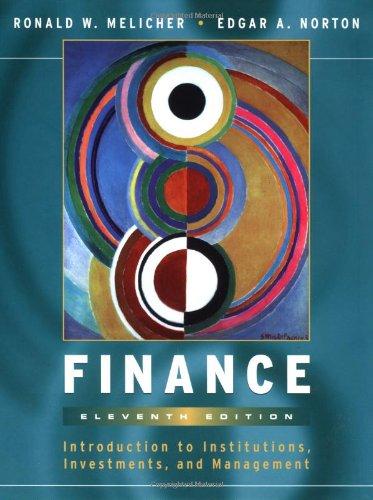Question
1. Consider a two-period, two-state world. Let the current stock price be 45 and the risk-free rate is 5 percent. Each period the stock price
1. Consider a two-period, two-state world. Let the current stock price be 45 and the risk-free rate is 5 percent. Each period the stock price can go either up by 10 percent or down by 10 percent. A call option expiring at the end of the second period has an exercise price of 40.
a. Find the stock price sequence. b. Determine the possible prices of the call at expiration. c. Find the possible prices of the call at the end of the first period. d. What is the current price of the call? e. What is the initial hedge ratio? f. What is (are) the subsequent hedge ratio(s)? g. Construct an example showing (similar to FIGURE 4.4) how the hedge works and illustrating how the hedge portfolio earns the risk-free rate in each period.

Answer Key for Q2 from (a to f) I need you to solve G as figure 4.4 Plese draw it as shown in the photo.
a.
Su = 45*(1.10) = 49.50 Su 2 = 45*(1.10) 2 = 54.45 Sd = 45*(.90) = 40.50 sd 2 = 45*(.90) 2 = 36.45 Sud = 45*(1.10)(0.90) = 44.55
b.
Cu 2 = Max (0, 54.45 40) = 14.45
C ud = Max (0, 44.55 40) = 4.55
Cd2 = Max (0, 36.45 40) = 0
c.
P = 0.75 1 p = 0.25
Cu = [(14.45)(.75) + (4.55)(.25)] 1.05 = 11.40
Cd = [(4.55)(.75) + (0.00)(.25)] 1.05 = 3.25
d.
C = [(11.40)(.75) + (3.25)(.25)] 1.05 = 0.8.92
e.
h = (11.40 3.25) (49.50 40.50) = 0.9056
f.
hu = (14.45 4.55) (54.45 44.55) = 1
hd = (4.55 0) (44.55 36.45) = 0.5617
g. ???????????
FIGURE 4.4 Two-Period Binomial Example u2s 156.25 Cu2 56.25 Vu2 701 (156.25) 701(56.25) us = 1 25 Cu31.54 Vu 701(125) 1,000(31.54) 9,430 (1.07) 60,010 = 56,085 rh = (60,010/56,080)- 07 rh = (56,085/52,410)- 07 hu1.0000 Buy 299 calls 31.54 ($9,430) Borrow $9,430 Hold 701 shares 125, short 70l udS I00 S 100 calls31.54, debt of $9,430 Cud-0.00 Vud- 701 (100)- 70i (0.0) C 17.69 Hold 701 shares @ 100, short 1,000 V 701 (100) 1,000(17.69) 9,430(1.07) 60,010 rh (60,010/56,085)-.07 Vdu 0(100) 1,000 (0.00) calls 17.69 dS 80 Cd0.00 Vd 701(80) 1,000(0.00) 52,410 + 56,080 (1.07) 60,006 = 56,080 rh(60,006/56,080) I.07 rh-(56,080/52,410)-1a,07 hd0.00 Sell 701 shares @ 80 ($56,080) Invest $56,080 in bonds Hold 0 shares @ 80, short 1,000 d2s 64 calls0.00, hold $56,080 in bonds Cd2 0.00 Vd2 0(64) 1,000 (0.00) + 56,080 (1.07) 60,006 r,-(60,006/56,080)-|-07Step by Step Solution
There are 3 Steps involved in it
Step: 1

Get Instant Access to Expert-Tailored Solutions
See step-by-step solutions with expert insights and AI powered tools for academic success
Step: 2

Step: 3

Ace Your Homework with AI
Get the answers you need in no time with our AI-driven, step-by-step assistance
Get Started


